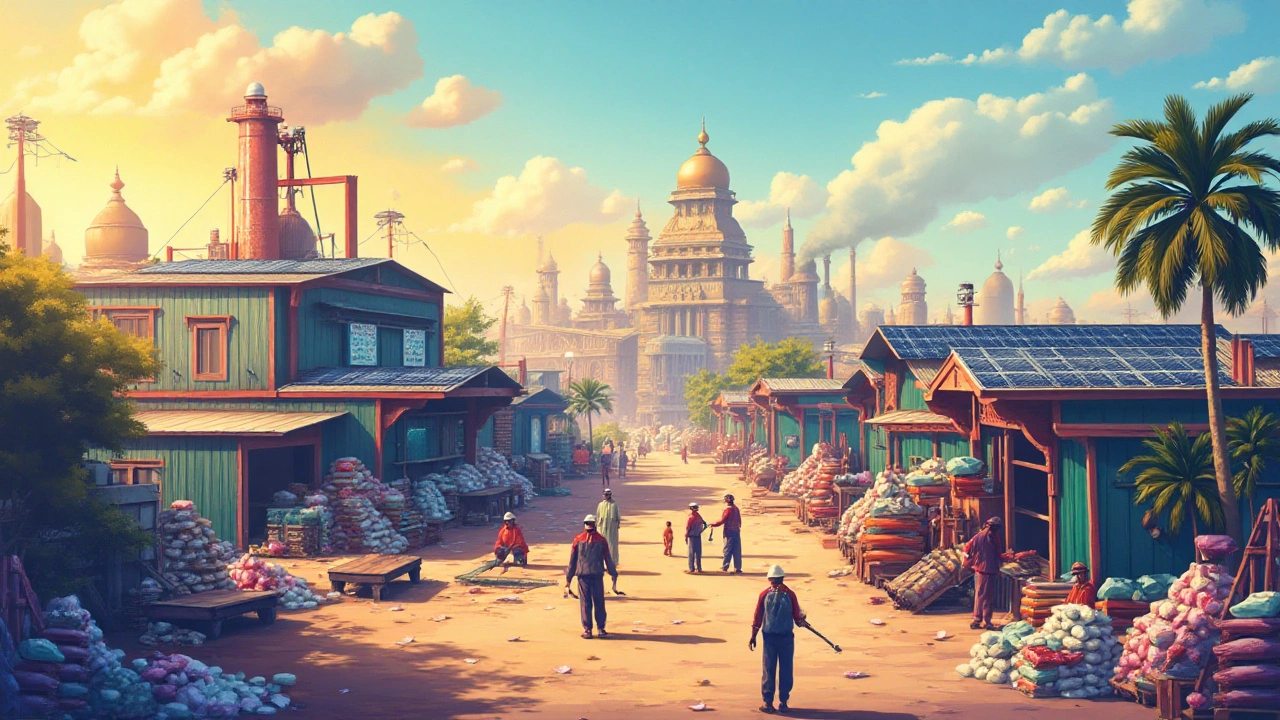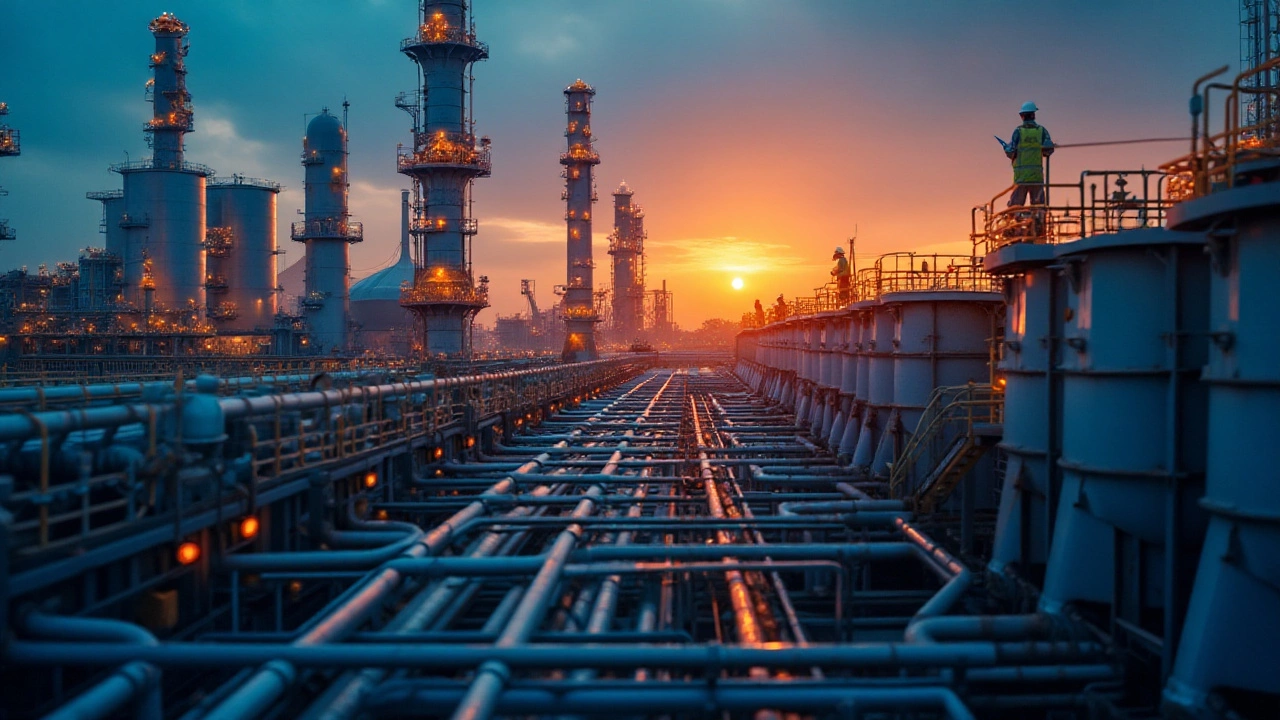 Feb, 1 2025
Feb, 1 2025
The world of plastic manufacturing is as vast as it is essential to modern life, stretching into every corner of the globe. It has woven itself into the fabric of daily routines, from the packaging that preserves food to the gadgets driving our digital age. Yet, even in this expansive field, towering giants stand above the rest, shaping the industry with their innovation and scale.
As we delve into the world of plastic production, it's impossible to ignore the remarkable influence of the sector's top players. These companies not only command a significant share of the market but also spearhead developments in sustainable practices and technological advancements. Join us as we explore who stands at the pinnacle, reigning as the biggest plastic producer globally, and examine the pivotal roles these companies play in the industry at large.
- The Rise of Plastic Manufacturing Giants
- Profiling the Biggest Plastic Producer
- Key Players in the Global Market
- Sustainability and Future Directions
The Rise of Plastic Manufacturing Giants
The journey toward the dominance of today's plastic manufacturing giants is one woven with innovation, strategic expansion, and responding to ever-evolving global demands. The post-World War II era signaled the start of an exponential increase in plastic production, spurred by industrial advancements and the material's unique properties such as flexibility, durability, and affordability. During this time, many companies realigned their focus toward synthetic polymers, which gradually became integral to various industries, from automotive to healthcare. The commercialization of plastics began to take a stronghold in the 1950s and 60s, with companies establishing production facilities close to raw material sources, ensuring both a steady supply and reduced logistical costs.
It's intriguing to note how modernization and technological advancements intertwined with the plastic realm. The rapid development of new plastic types – such as polyethylene, polyvinyl chloride (PVC), and polypropylene – provided solutions for countless applications. As consumers demanded more, plastic producers ramped up their efforts, adopting cutting-edge technologies to boost production efficiency and meet diverse needs across the world. In just a few decades, certain manufacturers emerged as industry leaders by heavily investing in R&D, ensuring not just quantity but also innovation in product offerings. Such manufacturers became synonymous with quality and reliability, traits that played crucial roles in setting them apart from their competitors.
The era also saw noteworthy strategic mergers and acquisitions, allowing companies to consolidate and strengthen their market positions. By integrating resources and streamlining operations, these manufacturing behemoths expanded their global footprint. The result? A landscape dominated by a handful of titans, each influencing market trends and reshaping industries reliant on plastics. As these companies grew, so did their role in the global economy, employing thousands and contributing significantly to GDPs of major industrial nations. When examining their rise, it's fascinating how these entities transformed, from humble beginnings to global powerhouses fueled by a quest for innovation and excellence.
"The growth in plastic production has been nothing short of transformative, reshaping industries and even societal norms," remarked an industry expert in a recent panel discussion. The influence of these giants extends beyond manufacturing; they play pivotal roles in shaping policy and research directions, often dictating the sustainable practices of the future. For the environmentally conscious, a major motivation is to balance production efficiency with sustainability, a commitment many leading firms now fervently uphold.
However, it is not all straightforward. The surge in plastic use has ushered in complex challenges related to waste management and environmental impact. Yet, instead of retreating, industry leaders tackled these obstacles head-on. By pioneering eco-friendly initiatives and launching recycling innovations, they have aimed at mitigating the repercussions of extensive production, evidencing a shift toward responsible manufacturing.
The rise of plastic manufacturing giants is a testament to human ingenuity and adaptability, driven by both ambition and necessity. As companies continue to navigate the dynamic landscape, they do so with an eye toward sustainability, ensuring their legacies endure and evolve with the changing tides of societal needs. Exploring these beginnings and trajectories gives insight not only into the history of these institutions but also into the industry’s promising future.
Profiling the Biggest Plastic Producer
In the sprawling realm of plastic manufacturing, one name consistently rises to prominence: ExxonMobil Chemical. Widely recognized as the largest plastic producer by volume, this titan of industry plays a crucial role in global plastic supplies. With origins tracing back more than a century within the oil industry, ExxonMobil has gradually extended its reach into the realm of petrochemicals, specifically honing its expertise to manufacture a variety of plastic products. Their impressive production facilities are strategically scattered across different continents, ensuring a steady flow of materials to meet international demand. The sheer scale of their operations allows for economies of scale that few competitors can match, offering cost efficiencies that keep them at the forefront of the industry.
Among the myriad products, polyethylene stands out as ExxonMobil’s crown jewel, a versatile plastic found in everything from packaging films to piping. This dominance stems from their highly efficient production processes which maximize yield and minimize waste—a critical factor in remaining an industry leader. The company’s continuous investment in cutting-edge technology further solidifies this position, allowing them to increase capacity and improve product quality consistently. It’s reported that ExxonMobil's production capacity exceeds that of smaller national producers, reflecting not only their ambition but also their adeptness at leveraging infrastructure and logistics effectively. In recent years, the company has expanded its repertoire to include advanced polymers, catering to the growing demand for high-performance plastics in sectors such as automotive and consumer electronics.
ExxonMobil's dedication to sustainability is also noteworthy. Over the past decade, the company has embarked on ambitious projects aiming to recycle chemical polymers and reduce their carbon footprint. A recent announcement from the company outlined its plan to achieve net-zero emissions by 2050, a strategy they argue will 'transform the way we think about plastics.' This commitment is part of a larger trend within the plastics industry, as key players strive to align profit with environmental responsibility. Reuters remarked, 'ExxonMobil's sustainability initiatives could set a new standard across the manufacturing sector, prompting a wave of green innovation.'
However, ExxonMobil is no stranger to controversy. Criticized for its role in the environmental challenges posed by plastics, the company has faced pressure from both governments and the public to adapt cleaner practices. Despite these challenges, the company continues to engage in dialogue with stakeholders to address concerns while striving to make plastics sustainable. Their dual focus on volume production and responsible growth exemplifies their complex but impactful presence in the global market. Positioned as both a leader and a trailblazer, ExxonMobil exemplifies the duality of plastic production in the 21st century—driven by quantitative might and qualitative transformation.

Key Players in the Global Market
In the sphere of plastic manufacturing, certain companies have made their marks as formidable leaders, not just in terms of sheer volume but also in their approach to innovation and sustainability. Among them, ExxonMobil Chemical holds a prominent position, celebrated as one of the largest plastic producers globally. With a focus that spans from raw petrochemical products to intricate polymers, ExxonMobil continually pushes the boundaries of what's possible in the global plastic companies arena. A notable example of their ingenuity is how they integrate advanced chemical engineering in their products, thereby setting the stage for enhanced environmental responsibility.
Meanwhile, Dow Chemical Company, another stalwart, stands as a beacon of innovation. Their influence in polymer production is substantial, and they hold notable patents that advance recycled plastics. Esteemed for their approach to sustainability, Dow's initiatives often weave together environmental stewardship with cutting-edge technology. They’ve been at the forefront of the move towards alternative solutions such as bio-based plastics, aiming to mitigate the environmental impacts associated with traditional plastic production.
BASF SE, hailing from Germany, further exemplifies the trend of integrating ecological considerations into large-scale production. Known for their significant contributions in developing biodegradable plastics, BASF’s initiatives often reflect their commitment to a circular economy. They seek not only to produce efficiently but also to minimize waste, possibly reshaping the public perception about plastic manufacturing through these ecological efforts.
Across the Pacific, SABIC, a Saudi company, solidifies its spot as a leader in the plastic industry. Its strength lies in its diversified portfolio and global network, producing a variety of plastic products that cater to diverse industries, from automotive to healthcare. SABIC’s investment in research and development is substantial, which cements their position as a proactive, solution-oriented player in the leading plastic manufacturer domain.
Beyond individual company achievements, industry leaders often collaborate to set frameworks for future development. Innovation in recycling strategies and the transition to sustainable practices are typically shared goals. These collaborative efforts among top producers often yield influential policies and groundbreaking technologies, which not only benefit the companies but also pave the way for other firms striving to make their marks on the industry.
According to a recent industry analysis, "These companies are not only leveraging their existing capacities but are genuinely strategic in their efforts supporting circular economies through extensive R&D investments." Such strategies underscore the leading companies' enduring commitment to forging a more sustainable future for the plastic manufacturing industry.
Sustainability and Future Directions
In recent years, the spotlight on sustainability has intensified, urging the plastic manufacturing industry to reimagine its approach. The biggest plastic producers are now more committed than ever to reducing their ecological footprint. This shift is not only due to regulatory pressures but also driven by an increasing consumer demand for environmentally friendly products. Initiatives are being taken to tackle the plastic waste crisis head-on, with companies innovating in recycling technologies and bioplastics. The move toward circular economy models suggests that discarded materials could soon become valuable resources rather than waste.
Many industry giants have established ambitious goals to decrease greenhouse gas emissions and increase the recyclability of their products. Shell's recent report indicates that by 2030, they aim to incorporate between 20% and 30% recycled content into their packaging lines worldwide. Meanwhile, Dow Inc., another leader in the field, has invested substantially in mechanical and chemical recycling technologies to minimize reliance on virgin plastic production. These strategies reflect a broader industry trend—the intertwining of business objectives with environmental stewardship.
"We envision a future where plastic waste is a thing of the past. Our mission aligns innovation with sustainability, creating a cycle where everything old becomes new again," stated Jim Fitterling, CEO of Dow Inc., highlighting their commitment to sustainable practices.
Amid these efforts, technological advancements play a pivotal role. Breakthroughs in converting plastic waste into fuel or developing biodegradable polymers offer promising avenues to alleviate pollution. This aligns with the vision of many global plastic companies to balance profitability and planetary health. Collaborative projects with environmental organizations and government bodies amplify these endeavors, demonstrating that a united front is crucial to overcoming ecological challenges.
Looking ahead, the future of plastic manufacturing hinges on innovation. Pioneering bio-based alternatives not only promises to reduce dependency on fossil fuels but also holds the key to producing plastics that decompose naturally, mitigating environmental impact. As companies strive towards these goals, investment in research and development remains vital. This decade presents an opportunity for leading plastic manufacturers to define what it means to be a responsible industry leader that not only meets current demands but anticipates the needs of generations to come.